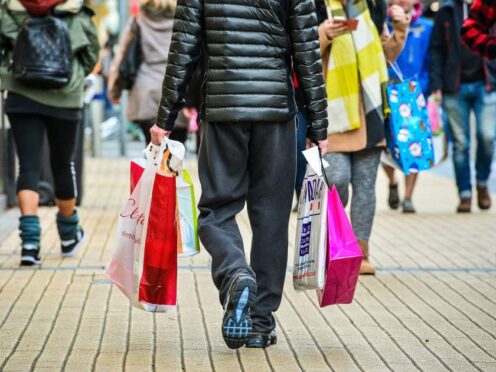
February proved to be an “underwhelming” month for Scottish retailers, with sales growth falling to its lowest level in two-and-a-half years, according to an industry body.
The Scottish Retail Consortium (SRC) said “some bright spots” such as buying linked to St Valentine’s Day had boosted the income of some stores over the last month.
The latest figures show total sales increased by 1.4% compared with the same period last year, when they grew by 9%.
Adjusted for inflation, however, the year-on-year decline worked out as 1.1%, according to the SRC.
David Lonsdale, director of the SRC, said: “February brought more discomfort for hard-pressed Scottish shopkeepers as total retail sales growth during the month fell further to its lowest level in two-and-a-half years.
“When adjusting for shop price inflation it was the eighth successive month of declining real terms growth.
“There were some bright spots. Some retailers benefited from purchases associated with St Valentine’s Day, buoyed by sales of cosmetics, fragrances and chocolates.
“Grocery sales got a bump too from St Valentine’s Day as people marked the occasion at home rather than spend more going out to eat.”
Mr Lonsdale said February’s “underwhelming” headline figures reflected “a continuing weakness in consumer demand” as well as a dip in shopper footfall.
He continued: “This weakness was most pronounced in bigger ticket categories such as white goods, furniture and jewellery.
“By contrast, lower-value items, including health and beauty and home accessories, fared reasonably well, with fashion buoyed by discounting as shops made room for new ranges.
“The growth in food continued to slow and was at its weakest level since June 2022.
“The figures suggest there has been as yet little discernible uplift to retail sales from the UK Government’s cut in employee national insurance contributions, which were introduced in January.
“It underlines the need for the Chancellor to put supporting consumer sentiment and spending at the heart of his spring Budget, including a restoration of tax-free shopping to tempt more international visitors to Scotland and the UK.
“If the UK administration reduces income tax rates for modest earners then Scottish ministers should give a fair wind to considering whether Scots should benefit too.”
Linda Ellett, UK head of consumer, retail and leisure at KPMG, said: “Despite, on the face of it, figures showcasing an increase, the wider picture has heralded a slow start to the year in Scotland for its retailers.
“What looked like a promising start to February was soon replaced with a more downbeat end as a mix of poor weather and people watching their spending more closely following Christmas and New Year.
“Fitness and beauty were high points in terms of sales, but other non-food sectors were weak. A push for healthier eating since the start of the year saw food sales remain solid if not spectacular.
“News that the UK economy is technically in recession, as many households continue to adapt budgets to meet higher essential costs, including higher mortgage rates, will do little to ease the consumer reluctance to get out there and start spending again.
“With big increases in labour costs and business rates just weeks away, adding an already stressed cost agenda for retailers, many will be pinning their hopes on some good news in the Chancellor’s spring statement this week, to help kick-start a spending revival on the high street.
“However, after two years of navigating the cost-of-living crisis, weary households continue to count the pennies.
“The assumption that having more spending power will lead to more spending isn’t cutting through at the moment and retailers will continue to face significant downward pressures on demand for some time to come.”

Enjoy the convenience of having The Sunday Post delivered as a digital ePaper straight to your smartphone, tablet or computer.
Subscribe for only £5.49 a month and enjoy all the benefits of the printed paper as a digital replica.
Subscribe